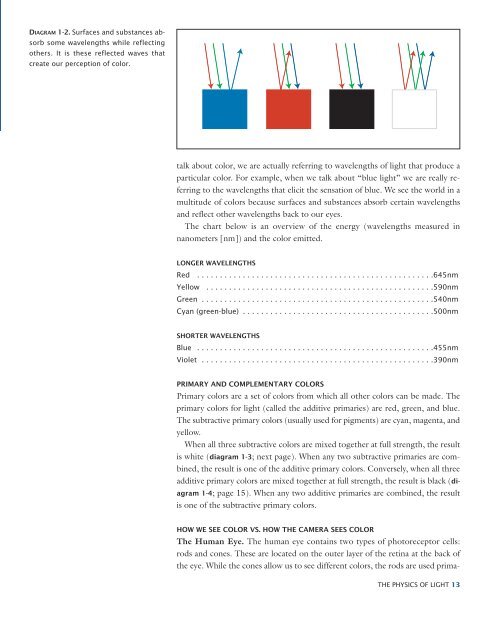Light Modifiers
You also want an ePaper? Increase the reach of your titles
YUMPU automatically turns print PDFs into web optimized ePapers that Google loves.
DIAGRAM 1-2. Surfaces and substances ab-<br />
sorb some wavelengths while reflecting<br />
others. It is these reflected waves that<br />
create our perception of color.<br />
talk about color, we are actually referring to wavelengths of light that produce a<br />
particular color. For example, when we talk about “blue light” we are really referring<br />
to the wavelengths that elicit the sensation of blue. We see the world in a<br />
multitude of colors because surfaces and substances absorb certain wavelengths<br />
and reflect other wavelengths back to our eyes.<br />
The chart below is an overview of the energy (wavelengths measured in<br />
nanometers [nm]) and the color emitted.<br />
LONGER WAVELENGTHS<br />
Red . . . . . . . . . . . . . . . . . . . . . . . . . . . . . . . . . . . . . . . . . . . . . . . . . . . .645nm<br />
Yellow . . . . . . . . . . . . . . . . . . . . . . . . . . . . . . . . . . . . . . . . . . . . . . . . . .590nm<br />
Green . . . . . . . . . . . . . . . . . . . . . . . . . . . . . . . . . . . . . . . . . . . . . . . . . . .540nm<br />
Cyan (green-blue) . . . . . . . . . . . . . . . . . . . . . . . . . . . . . . . . . . . . . . . . . .500nm<br />
SHORTER WAVELENGTHS<br />
Blue . . . . . . . . . . . . . . . . . . . . . . . . . . . . . . . . . . . . . . . . . . . . . . . . . . . .455nm<br />
Violet . . . . . . . . . . . . . . . . . . . . . . . . . . . . . . . . . . . . . . . . . . . . . . . . . . .390nm<br />
PRIMARY AND COMPLEMENTARY COLORS<br />
Primary colors are a set of colors from which all other colors can be made. The<br />
primary colors for light (called the additive primaries) are red, green, and blue.<br />
The subtractive primary colors (usually used for pigments) are cyan, magenta, and<br />
yellow.<br />
When all three subtractive colors are mixed together at full strength, the result<br />
is white (diagram 1-3; next page). When any two subtractive primaries are combined,<br />
the result is one of the additive primary colors. Conversely, when all three<br />
additive primary colors are mixed together at full strength, the result is black (diagram<br />
1-4; page 15). When any two additive primaries are combined, the result<br />
is one of the subtractive primary colors.<br />
HOW WE SEE COLOR VS. HOW THE CAMERA SEES COLOR<br />
The Human Eye. The human eye contains two types of photoreceptor cells:<br />
rods and cones. These are located on the outer layer of the retina at the back of<br />
the eye. While the cones allow us to see different colors, the rods are used prima-<br />
THE PHYSICS OF LIGHT 13



